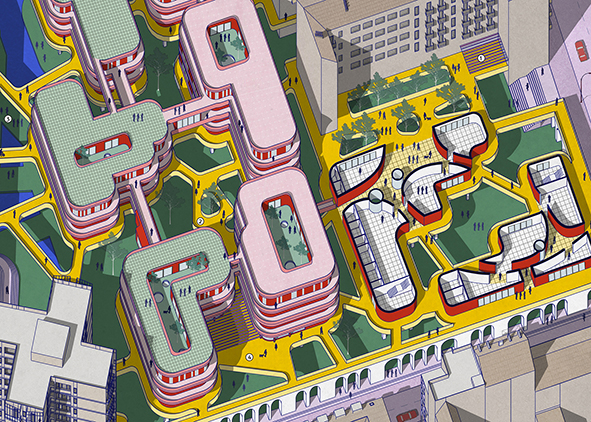Diy-City and internet of things. A research hypothesis around interactive urban design
DOI:
https://doi.org/10.19229/2464-9309/1042021Keywords:
internet of things, smart cities, participation, urban design, digital citizenshipAbstract
In a renewed and critical interpretation of the idea of the so-called ‘smart city’, it may serve to prefigure a paradigm shift in urban design: from the apparently irresolvable opposition between top-down and bottom-up processes that marked the debates on participatory design in the last quarter of the 20th century, it will be possible to move towards the idea of collaboration between citizens, businesses and institutions that is both top-down and bottom-up. The tools offered by digital technologies can in fact promise a horizon of ‘co-making’, understood as an interactive urban project, capable of refining the production of the city space, but also of expressing its social and symbolic value and finally of conceiving and designing innovative urban scenarios in a more participatory way. In order to do this, the research hypothesis illustrated prefigures a sort of Turing machine of urban design, capable of transforming data (voluntarily and involuntarily provided by citizens) into actions aimed at designing the space of the city.
Downloads
Article Metrics Graph
References
Alexander, C. (1979), The timeless way of building, Oxford University Press, New York.
Banham, R., Barker, P., Hall, P. and Price, C. (1969), “Non-Plan – An experiment in freedom”, in New Society, n. 338, pp. 435-443.
Batty, M. (2018), Inventing Future Cities, The MIT Press, Cambridge (MA).
Batty, M. (2013), “Big data, smart cities and city planning”, in Dialogues in Human Geography, vol. 3, issue 3, pp. 274-279. [Online] Available at: doi.org/10.1177/2043820613513390 [Accessed 25 October 2021].
Coleman, G. (2015), Hacker, Hoaxer, Whistleblower, Spy – The Many Faces of Anonymous, Verso Books, London/New York.
Crang, M. and Graham, S. (2007), “Sentient cities – Ambient intelligence and the politics of urban space”, in Information, Communication & Society, vol. 10, issue 6, pp. 789-817. [Online] Available at: doi.org/10.1080/13691180701750991 [Accessed 25 October 2021].
de Waal, M. (2014), The City as Interface – How Digital Media are Changing the City, Nai010 Publishers, Rotterdam.
Del Signore, M. and Riether, G. (2018), Urban Machines – Public Space in a Digital Culture, LISTLab, Trento.
Garrett, B. (2013), Explore everything – Place-hacking the city, Verso Books, New York.
Himanen, P. (2001), The Hacker Ethic and the Spirit of the Information Age, Random House, New York.
Kitchin, R. (2014), “The real-time city? Big data and smart urbanism”, in GeoJournal, vol. 79, pp. 1-14. [Online] Available at: doi.org/10.1007/s10708-013-9516-8 [Accessed 25 October 2021].
Kitchin, R. and Dodge, M. (2011), Code/Space – Software and Everyday Life, MIT Press, Cambridge (MA).
Konomi, S. and Roussos, G. (2016), Enriching Urban Spaces with Ambient computing, the Internet of Things and Smart City Design, IGI Global Hershey, Philadelphia.
Levy, S. (1984), Hackers – Heroes of the Computer Revolution, Doubleday, New York.
Lim, C. J. and Liu, E. (2019), Smartcities, Resilient Landscapes and Eco-Warriors, Routledge, Oxford/New York.
Manovich, L. (2001), The Illusions – A BIT of The Language of Media, The MIT Press, Cambridge (MA).
Mattern, S. C. (2021), A City Is Not a Computer – Other Urban Intelligences, Princeton University Press, Princeton.
McCullough, M. (2013), Ambient commons – Attention in the age of embodied information, The MIT Press, Cambridge (MA).
Miessen, M. (2010), The nightmare of participation (Crossbench Praxis as a Mode of Criticality), Sternberg Press, Berlin.
Mitchell, W. J. (2005), Placing Words – Symbols, Space, and the City, The MIT Press, Cambridge (MA).
Neirotti, P., De Marco, A., Cagliano, A. C., Mangano, G. and Scorrano, F. (2014), “Current trends in Smart City initiatives – Some stylised facts”, in Cities, vol. 38, pp. 25-36. [Online] Available at: doi.org/10.1016/j.cities.2013.12.010 [Accessed 25 October 2021].
Picon, A. (2015), Smart Cities – A Spatialised Intelligence, Wiley, Hoboken (US).
Rogers, R. (1997), Cities for a small planet, Faber & Faber, London.
Rudofsky, B. (1964), Architecture without architects – A short introduction to non-pedigreed architecture, Doubleday & Company, New York.
Sanoff, H. (2000), Community participation methods in design and planning, Wiley, Hoboken (US).
Shepard, M. (ed.) (2011), Sentient city – Ubiquitous computing, architecture, and the future of urban space, The MIT Press, Cambridge (MA).
Townsend, A. M. (2013), Smart cities – Big data, civic hackers, and the quest for a new utopia, W.W. Norton & Company, New York.
Trisciuoglio, M., Barosio, M., Ricchiardi, A., Tulumen, Z., Crapolicchio, M. and Gugliotta, R. (2021), “Transitional Morphologies and Urban Forms – Generation and Regeneration Processes – An Agenda”, in Sustainability, vol. 13, issue 11, 6233, pp. 1-19. [Online] Available at: doi.org/10.3390/su13116233 [Accessed 25 October 2021].
Vermesan, O. and Friess, P. (eds) (2014), Internet of Things – From Research and Innovation to Market Deployment, River Publishers, Aalbor.

Downloads
Published
How to Cite
Issue
Section
License
This Journal is published under Creative Commons Attribution Licence 4.0 (CC-BY).
License scheme | Legal code
This License allows anyone to:
Share: copy and redistribute the material in any medium or format.
Adapt: remix, transform, and build upon the material for any purpose, even commercially.
Under the following terms
Attribution: Users must give appropriate credit, provide a link to the license, and indicate if changes were made; users may do so in any reasonable manner, but not in any way that suggests the licensor endorses them or their use.
No additional restrictions: Users may not apply legal terms or technological measures that legally restrict others from doing anything the license permits.
Notices
Users do not have to comply with the license for elements of the material in the public domain or where your use is permitted by an applicable exception or limitation.
No warranties are given. The license may not give users all of the permissions necessary for their intended use. For example, other rights such as publicity, privacy, or moral rights may limit how you use the material.


















































































